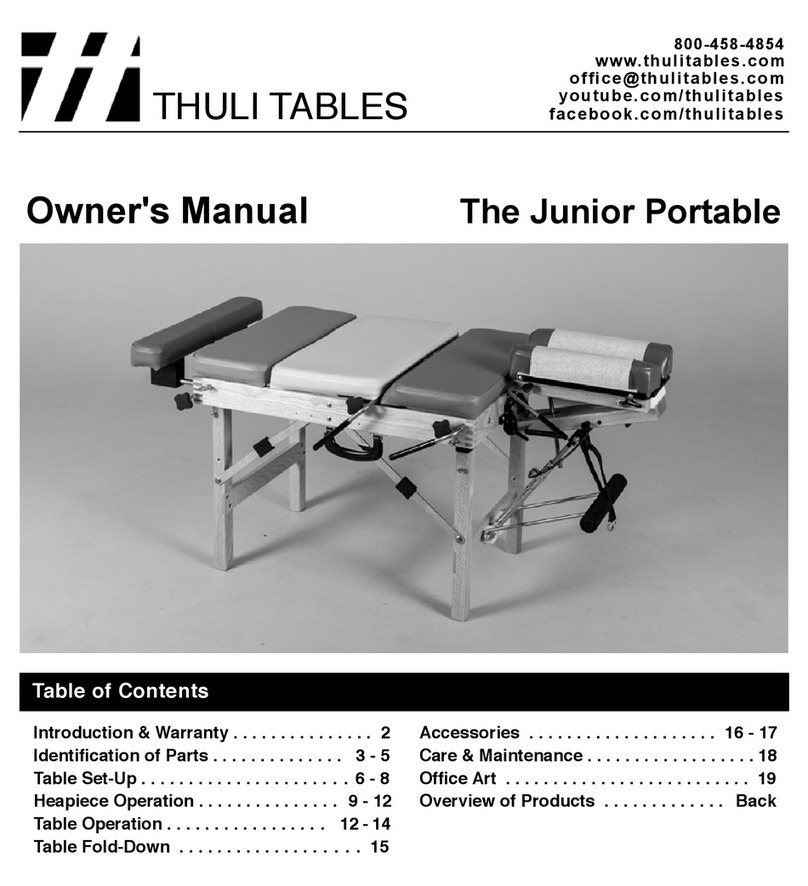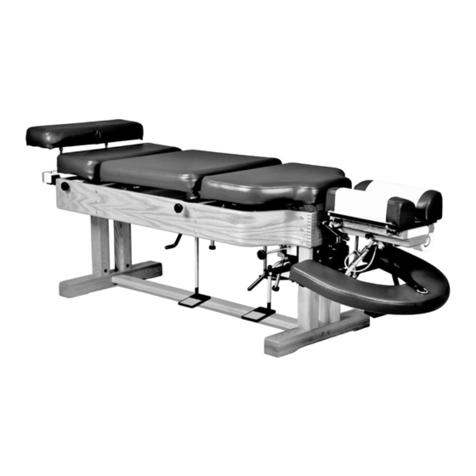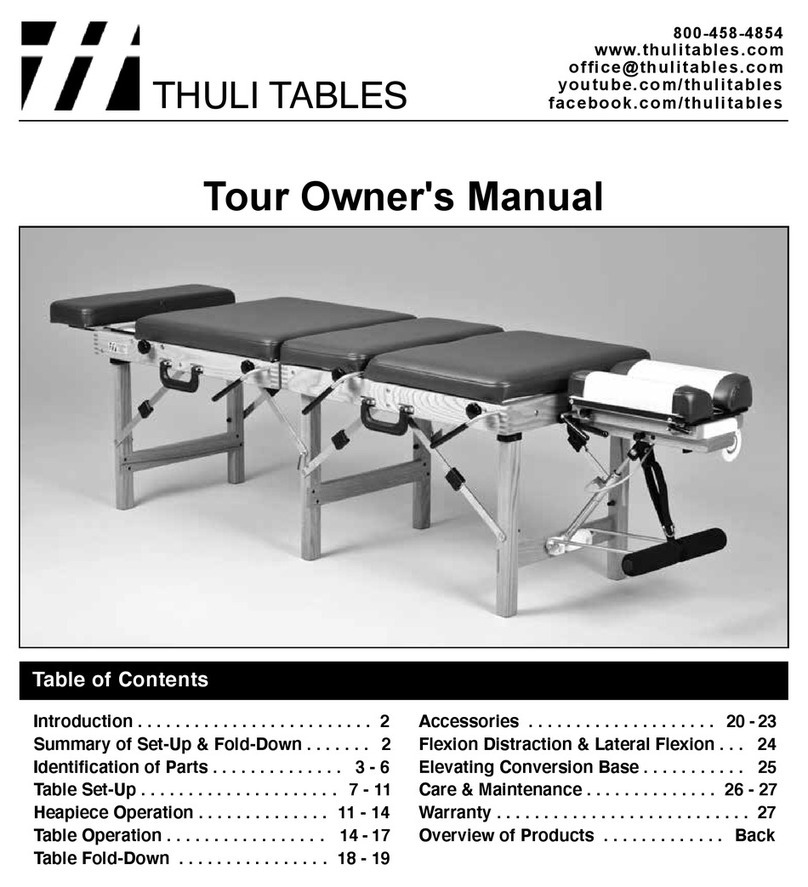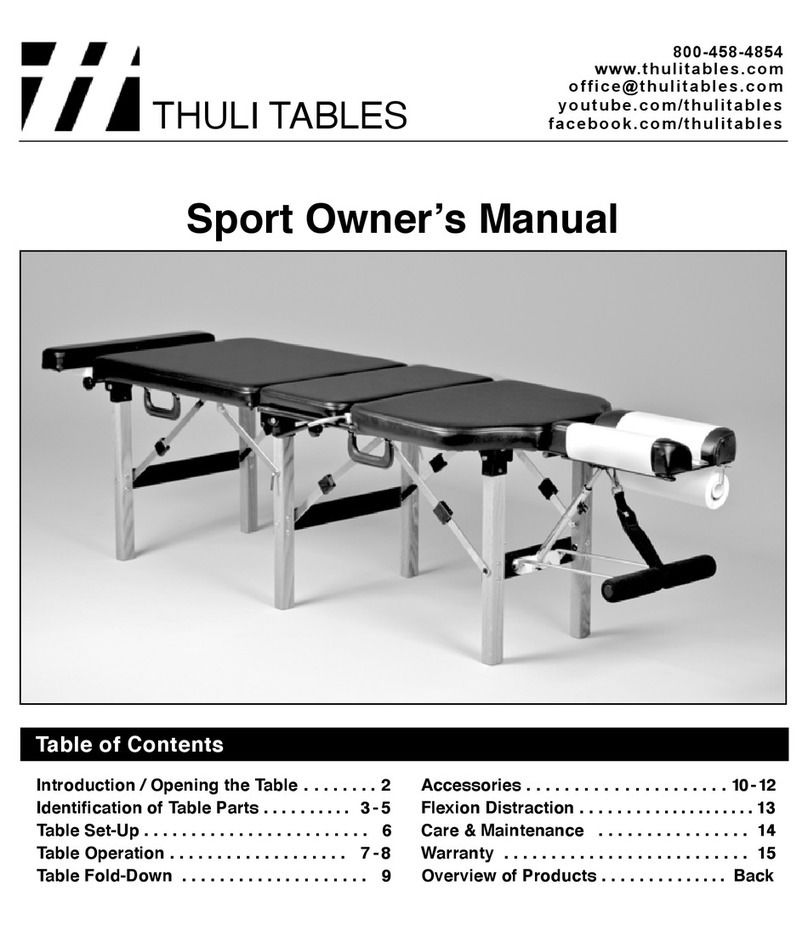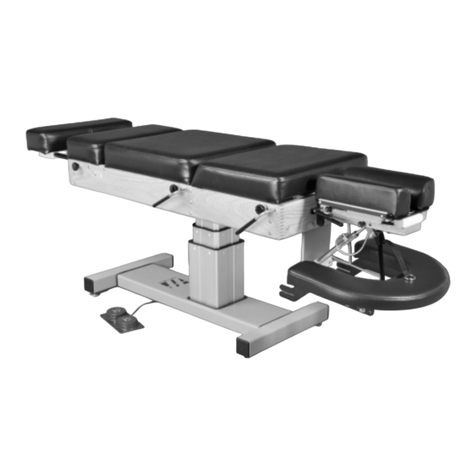Thuli Tables 300 Stationary User manual

Table of Contents
Introduction . . . . . . . . . . . . . . . . . . . . . . . . . 2
Identication of Parts . . . . . . . . . . . . . . . 3 - 4
Table Assembly . . . . . . . . . . . . . . . . . . . . . . 5
Headpiece Attachment & Operation . . . 6 - 10
Table Operation . . . . . . . . . . . . . . . . . . 11 - 12
Abdominal Swing-Away . . . . . . . . . . . . . . 13
Accessories . . . . . . . . . . . . . . . . . . . . . . . . 14
Care & Maintenance . . . . . . . . . . . . . . 15 - 16
Warranty . . . . . . . . . . . . . . . . . . . . . . . . . . . 17
Overview of Products . . . . . . . . . . . . . . Back
300 Stationary Owner’s Manual
THULI TABLES
www.thulitables.com
youtube.com/thulitables
800-458-4854
facebook.com/thulitables

2
Introduction
Rick Thuli, D.C.
President
Sincerely,
We are pleased to provide you with an aesthically beautiful chiropractic
adjusting table that is versatile and precisely engineered. It has been
thoroughly inspected and tested right down to the smallest detail before
leaving our shop. We are condent that it will provide you with many
years of reliable service.
Please take the time to read this manual carefully. It will familiarize you
with the table and instruct you on its proper operation and maintenance.
If you have any questions or comments, please contact us.
Thank you for your purchase of a 300 Stationary table.

Identification of Table Parts 3
Prone Arm Rest
Ankle Rest
Extension
Pelvic Section
Fixed Section
Thoracic Section
Headpiece
Stretcher
Ankle Rest
Extension
Locking Knob
Pelvic Cocking
Lever & Tension
Control Knob
Thoracic Cocking
Lever & Tension
Control Knob
Crossbrace
Piston

4
Identification of Headpiece Parts
Tension Control Knob
(back side)
Paper Hold-Down Wire
Pivot Block
Slide Block
Paper Hanger
Remote Control Lever
Paper Tear-Off Bar
Straight Drop / Forward
Cocking Lever
Headpiece Mounting
Remote Control Cable
Piston Pin
T-Bar
Piston Head
Lowering Lever
Prone Arm Rest Buckle
Flexion / Extension Prone Arm Rest
Locking Link
Piston
Motion Knob
Bracket

5
Table Assembly
1. Lay the table onto its cushions.
2. Remove the hitch pins and “O” rings from the ankle rest extension rods.
3. Loosen both locking knobs and slowly remove the wooden dowels from the
plastic housing (these dowels were installed for shipping purposes to keep
the spacer from falling out of the housing).
4. Insert the ankle rest extension rods through the frame and housings.
5. Replace the “O” rings and hitch pins.
ANKLE REST ATTACHMENT
TABLE LEGS ATTACHMENT
Attach the front and back leg sets to the table
frame by matching up the colored dots and using
the 12 sets of fasteners provided. Insert the bolt
(rst through the frame and then through the
leg). Slide on the washer, lockwasher and nut and
tighten down.
STRETCHER ATTACHMENT
Attach the long stretcher to the front and back
leg sets using the four remaining lag bolts.
Engage the short end of the allen wrench rmly
into the recess of the bolt to avoid stripping it out
when tightening.
Your table is easy to assemble. For protection during shipping, the headpiece, ankle rest extension and legs are packaged
separately from the table. We have included two different wrenches to assist you in the assembly process.
Paper Hold-Down Wire

6
Headpiece Attachment
HEADPIECE T-BAR HEADPIECE ATTACHMENT
1. Place the headpiece onto its cushions at the front of the table.
2. Lift the slide block to a 45 degree angle.
3. Insert the long rod of the T-bar through the hole in the locking
link of the slide block.
4. Lower the slide block to a closed position by applying
counterclockwise (downward) pressure to the lowering lever.
LATERAL FLEXION Proceed to the next step if your
headpiece does not have Lateral Flexion.
1. With the 9/16” wrench provided, attach the headpiece to the
table using the four hex bolts and lockwashers.
2. Proceed to step “Headpiece Paper”.
PISTON / PRONE ARM REST ATTACHMENT
1. Attach the piston/prone arm rest to the crossbrace of the front
leg set using the fasteners provided, matching up the colored dots.
2. Swing the piston/prone arm rest up and out of the way to
provide room for attaching the headpiece.
5. To attach the headpiece to the table, slide the slide block into
the mounting bracket.
6. Visually line up the hole of the slide block with the holes
closest to the cushions in the mounting bracket and insert
the mounting pin with a twisting motion.
Note: If you are using the Comfort Pillow, the slide block will
have a white block attached to it. Line up the hole in this block
with the holes farthest from the cushions in the mounting bracket.
Insert the closing/mounting pin with a twisting motion.

HEADPIECE ATTACHMENT
PISTON ATTACHMENT
1. Swing the exion/extension piston down toward the
off-centered slot in the base block.
2. Remove the piston pin from the slide block and raise the front
end of the headpiece to allow the piston to engage in the
off-centered slot. Operating the remote control will allow you
to rotate the piston head to align with the off-centered slot.
3. Attach the piston to the slide block by visually lining up the
holes and re-inserting the piston pin.
Install the remote control into the bottom of the slide block.
Insert the cable into the narrow slot and tilt the remote control
into the recess until it snaps into place. Operating the remote
control will allow the headpiece to lay ush with the table cushions.
Headpiece Attachment & Headpiece Paper
1. Install a standard 8.5” roll of headpiece
paper.
2. Raise the paper hold-down wire and
tear-off bar. Advance the paper and
tuck it between the cushions.
3. Lower the hold-down wire between
the cushions, lower the tear-off bar
and tear off any excess paper.
HEADPIECE PAPER
4. To advance the headpiece paper, raise
the tear-off bar, hold your nger on
the hold-down wire and pull the paper
across the cushions. Pulling the paper
in an upward direction will reduce
friction, making it easier to pull.
5. To tear off used headpiece paper, use an
upward motion while holding down the
tear-off bar.
7
REMOTE CONTROL ATTACHMENT

8
Headpiece Operation
STRAIGHT DROP FORWARD MOTION DROP
FLEXION / EXTENSION
Flex and extend the headpiece by
grasping the front end of the headpiece
and operating the remote control lever.
LATERAL FLEXION (optional)
To ex the headpiece laterally, turn the
lateral exion lever in a counterclockwise
direction, manually position the headpiece,
then lock it into position by tightening
the lateral exion lever. This can be done
while the headpiece is in the exed,
extended or elevated position.
LATERAL FLEXION LEVER
The position of the lateral exion lever
can be changed. With the lateral exion
lever tightened, pull the lever directly
outward, rotate to the desired position
and release.
Knob pulled out
PRIOR to cocking
Knob pushed in PRIOR to cocking
PRIOR to cocking the headpiece, set for straight drop by
pulling out the headpiece straight drop/forward motion knob
until you feel it is “set” into position. This will be just short
of coming into contact with the cocking bar. If you pull the
knob out too far, simply push it back in and continue.
PRIOR to cocking the headpiece, set for forward motion drop by
pushing in the headpiece straight drop/forward motion knob.
Cock the headpiece with an upward motion on the headpiece cocking lever.
Please note: Be sure to change the headpiece drop function
before cocking the headpiece to prevent an ineffective drop and
damage to the drop mechanism.
Set the desired tension by turning the tension control knob clockwise (increasing tension) or counter-clockwise (decreasing tension).

9
VERTICAL ELEVATION
Headpiece Operation
1. Raise the back end of the headpiece
by lifting the red grip of the cocking
lever (without operating the lever).
Caution: Do not grasp the cushions to
raise the back end, which could stretch
and damage the small springs.
2. Raise the front end of the headpiece
by operating the remote control lever.
3. With practice, steps 1 and 2 can be
combined to vertically raise the
headpiece in one smooth motion.
VERTICAL LOWERING
1. Lower the front end of the headpiece
by operating the remote control lever.
2. In one smooth motion, lower the back
end of the headpiece by lifting the
headpiece lowering lever rmly with
one hand while gently lowering the
back end of the headpiece with the
other.
Advise your patient before changing the
position of the headpiece. This is especially
important when lowering the back end of the
headpiece (step 2). Failure to gently lower
the back end of the headpiece may result in
its sudden drop, causing possible alarm to
the patient.
IMPORTANT

10
Headpiece Operation
PRONE POSITION
EYE COMFORT IN PRONE POSITION
For patients who are sensitive to pressure on their eyes, slightly raise the back end of the
headpiece. This will take pressure off of the eyes by supporting the weight of the head
at the mandible and zygomatic arches. Using this maneuver, in combination with slight
exing of the headpiece, will provide additional comfort for many patients.
Side posture positioning of the patient’s
head for lumbo-pelvic adjusting or
toggle recoil adjusting.
SIDE POSTURE POSITION SUPINE POSITION
Position the headpiece vertically to give
maximum support of the cervical spine and
patient’s head when in a supine position.
Position the patient sufciently forward
with arms outstretched and wrists resting
comfortably on the Prone Arm Rest, which
is adjustable in height. To raise, pull on
the loop at the end of the strap. To lower,
squeeze the cam lock (to loosen the strap)
and pull down on the Prone Arm Rest
grips. Advise the patient not to apply
weight on the Prone Arm Rest while
getting up from the table.
HEADPIECE CUSHIONS: ADJUSTABLE WIDTH
Neutral position. Narrower position for smaller faces
(eg children).
Wider position takes pressure off
of the patient's eyes.
The headpiece cushions are easily adjustable in width at the front end for individualized patient comfort. Firmly pull up on the front
end of each headpiece cushion and move in (one or two notches) or out (one or two notches) to desired position. Secure cushions
by engaging locating pins into notches provided.

11
Table Operation
SETTING THE TENSION
The pelvic and thoracic drop sections have adjustable tension and
cock with an upward movement of the cocking lever.
PELVIC DROP
Position the patient’s anterior superior iliac spine (ASIS) at
the juncture of the pelvic and thoracic sections.
Position the patient sufciently forward with their arms out-
stretched and wrists resting on the prone arm rest. This will
insure that the skin on the back of the patient’s arms will not
be pinched between the thoracic section and the table frame
when using the drop.
THORACIC DROP
1. With the patient on the table, cock the drop section. You must
have sufcient tension on the drop mechanism to hold the
patient’s weight.
2. Loosen the tension control knob by turning it counterclockwise
until the section drops.
3. Turn the tension control knob clockwise 3 - 4 half turns. As a
general rule, the drop is now set for the patient’s weight, which
may vary according to the practitioner’s preference.
Pelvic Drop Thoracic Drop
Before setting the tension, advise your patient of your intention.

12
ANKLE REST EXTENSION
The ankle rest can be extended up to 11”
to accommodate taller patients. Shorter
patients can drop their feet into the recess
created by the extended ankle rest.
Locking knobs are provided on both sides
of the table.
ANKLE REST ELEVATION AND LOWERING (optional feature)
To ELEVATE, simply lift up on the
ankle rest.
To LOWER, lift the center of the wood
bar with one hand while gently lowering
the ankle rest with the other hand.
THORACIC INCLINE
Uses of the thoracic incline include anterior thoracic adjusting,
cervical palpation and diversied cervical adjusting. This
feature allows the practitioner to remain in a comfortable,
upright position.
CERVICAL PALPATION & ADJUSTING
ANTERIOR THORACIC ADJUSTING
Table Operation
The thoracic section can be raised to a 20 degree angle. Lift the
thoracic section, swing the slant bar down and allow the rubber
tips to rest on top of the front legs (the right arm of the slant bar
will straddle the thoracic tension control knob).

ABDOMINAL SWING-AWAY
Activate the lever on either side of the table while depressing
the abdominal section. This can be done before the patient lays
on the table or while the patient is on the table. Adjust the
positon of the abdominal swing-away to the patient’s comfort.
The abdominal swing-away section offers prone
comfort to pregnant patients or to those of us with
“a little extra around the middle.”
Table Operation: Abdominal Swing-Away (optional feature) 13
The chest cushions are attached by four magnets.
To remove the cushion, simply grasp at both sides
and twist (toward the headpiece) with a lifting
motion. The cushion is held in correct position by
aligning the two holes on the underside of the chest
cushion with the two nickel-plated acorn nuts on the
thoraic drop plate.
CHEST CUSHION STORAGE
When not using the chest cushion, consider:
1. Storing it in the space vacated by the extended
ankle rest section (photo above).
2. Use it as a bolster under the patient’s ankles when
lying prone.
3. Use it as a bolster under the patient’s knees when
lying supine.
CHEST CUSHION PLACEMENT
Firm Chest Cushion
This cushion has a foam density that matches the rmness of
the rest of the table. It is ideal for thoracic drop adjusting.
Soft Chest Cushion
INTERCHANGEABLE CHEST CUSHIONS
This cushion provides a combination of soft foam in the breast
area and rmer foam surrounding, insuring adequate thoracic
support when the patient is lying prone or supine.

14
14
CRESCENT ARM REST
The Crescent Arm Rest provides additional forearm support in the
prone position. Simply slide both slotted ends of the bracket onto
the bolts located on the inside of the front legs and push down onto
the standard Prone Arm Rest. The Crescent Arm Rest will snap
into place. Its positions are easily adjustable. Can be retrotted to
your table at anytime (minimal installation required).
Rotate the Comfort Pillow 180
degrees to provide cervical
support in the supine position.
COMFORT PILLOW
Base
Pillow
Accessories
The Comfort Pillow offers
massage quality comfort in the
prone position.
The Velcro on the
underside of the pillow
secures it to the base,
allowing for width
adjustability.
The base of the Comfort Pillow inserts into place between the
headpiece cushions. The opening is adjustable.
Comfort
Pillow
Crescent Arm Rest
Bolsters are 20" wide with a nonslip base. Choice of two
heights: 2.75" or 4.25". Use in prone position under ankles or in
supine position under knees to relax hamstrings.
BOLSTERS
2.75" x 20" Bolster (shown on Tour portable table)
PRONE ARM REST SHIELDS
Nonporous and durable plastic
shields slip over the prone arm rest
grips. Easy to sanitize.

Care & Maintenance
DROP MECHANISMS: CLEANING & LUBRICATION
Periodic lubrication of the drop mechanisms will ensure smooth, crisp drops. Apply 3-IN-ONE oil every month or 500 adjustments.
If the drops have not been lubricated on a regular basis, rst apply WD-40 to clean the plungers from dust & debris. See below.
CERVICAL DROP THORACIC & PELVIC DROPS
1. Raise the headpiece and cock the drop mechanism.
2. Apply 3-IN-ONE into the hole of the plastic block.
Allow a few minutes for the oil to penetrate before using.
1. Lay the table on its cushions.
2. Locate the thoracic and pelvic plungers.
2. Apply 3-IN-ONE oil onto the plungers. Allow a few
minutes for the oil to penetrate before using.
If the drop has not been lubricated on a regular basis:
Routine lubrication:
1. Apply WD-40 into the hole and then drop the headpiece
several times to clean the plunger from dust & debris.
2. Apply 3-IN-ONE oil into the hole for lubrication.
Routine lubrication:
If the drops have not been lubricated on a regular basis:
1. Lay the table on its cushions.
2. Apply WD-40 onto the plungers and allow a few minutes
for penetration. Set the table upright and drop each section
several times to clean from dust & debris.
2. Set the table back on its cushions and apply 3-IN-ONE oil
onto the plungers for lubrication. Allow a few minutes for
the oil to penetrate before setting the table upright. Drop each
section several times.
15
TENSION CONTROL ADJUSTMENT
The resistance on the tension control rod can be increased or decreased.
Locate the set screw on the bottom of the thoracic, pelvic and caudal
drop blocks. Use an 1/8" allen wrench to adjust.
Set Screw
Increase resistance: Turn the set screw clockwise. This is helpful
if the tension control rod is “backing out" while using the drop.
Decrease resistance: Turn the set screw counter-clockwise.

1416Vinyl Cleaning
VINYL CLEANING
1. Mild Daily Cleaning: Use dish soap and warm water (1:10) with a soft cloth. Follow with a thorough, clear water rinse.
If more cleaning is necessary, use a soft bristle brush with the same solution. Avoid harsh detergents and powdered abrasives.
Areas coming in contact with hair, body oils or perspiration should be washed frequently. Remove stains immediately to prevent
the possibility of becoming permanent.
2. Disinfecting Options:
Bleach: Dilute 4 tsp bleach in 1 quart of water in a spray bottle. Spray on vinyl, leave for 1-2 minutes and rinse well with water.
Hydrogen Peroxide (3%): Available in spray bottle. Use undiluted and leave on for 5 minutes and rinse well with water.
Alcohol (70% min): Use undiluted. Leave on for 1-2 minutes and rinse well with water.
REPLACEMENT VINYL: In the event of wear or damage, pre-sewn replacement vinyl is available from Thuli Tables.
3. Water Rinse: It is important to follow cleaning with a thorough, clear water rinse to minimize premature deterioration of the
vinyl from extended exposure to chemicals.

Warranty 17
If your table needs repair, whether under warranty or not, please contact us. We will determine what is needed and, at our
discretion, send you either a replacement or the necessary part for repairing. Our tables have been designed so that replacing a part
is relatively easy to do yourself. Please note that we do not cover labor costs if you hire someone to install the replacement part
on your behalf.
Our tables are designed and built to high standards and we are proud to offer a limited lifetime warranty against manufacturing
defects. This warranty is valid to the original owner and only if the table has not been altered in any way. It does not cover issues
caused by normal wear and tear, which naturally and inevitably occur as a result of normal use over time, or damage caused by
accidents, improper use and negligence. It also not does not cover the headpiece exion/extension piston and the electric motor
(on elevating tables). These two items are covered by a one year warranty against manufacturing defects.

15

Elevation Tables
Tour Portable
300 Stationary
Sport Portable
500 Stationary
Portable Drops
Lumbo-Pelvic Drop
Extremity Drop
Speeder Board
Portable
Headpiece
Junior Portable
www.thulitables.com
608.935.9300
800.458.4854
youtube.com/thulitables
facebook.com/thulitables
This manual suits for next models
1
Table of contents
Other Thuli Tables Medical Equipment manuals
Popular Medical Equipment manuals by other brands

Getinge
Getinge Arjohuntleigh Nimbus 3 Professional Instructions for use

Mettler Electronics
Mettler Electronics Sonicator 730 Maintenance manual

Pressalit Care
Pressalit Care R1100 Mounting instruction

Denas MS
Denas MS DENAS-T operating manual

bort medical
bort medical ActiveColor quick guide

AccuVein
AccuVein AV400 user manual
